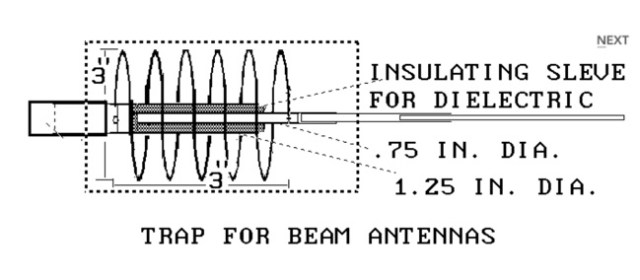Article by VE3GK
I was assembling a HY/GAIN, TH6DXX, a 10 – 15 and 20 meter beam the other day and thought there might be some interest in the function of the traps. I have also included some practical information on how
to build traps for a multi-band, 10-15-20 meter antenna.
RESONATE PARALLEL NETWORKS REVIEWED:

When a certain amount of capacitance is connected in parallel with a certain amount of inductance it results in a very high resistance at a certain frequency. In other words this combination of inductance and capacitance results in a special high resistance resistor designed to work at a narrow band of frequencies. Other frequencies above and below this frequency exhibit the opposite condition, a very low resistance.
TRI-BAND ANTENNA ELEMENT TRAP EXAMPLE: EXAMPLE:

When a Tri-band 10, 15 and 20 meter beam is excited with 21 MHZ energy only the length of element to the 21 MHZ trap is used.
The trap is situated 1/4 wave length from the boom of a yagi and is similar to that of an open switch.
The same electric circuit is present on 10 meters. Conversely, the 14 MHZ signal perceives the 21 and 28 MHZ traps as a closed switches at 14 MHZ. The 20 meter signal and uses the whole length of the element.
TYPICAL TRAP FOR 20–15–10–METER BEAM

Please refer to the following drawings for the practical application of the parallel tuned traps that are used in multi band beams and wire dipoles. The capacitor is made by inserting one aluminum tube inside another with an insulating sleeve in between serving as the dielectric.
The capacitance should be around 25 pf. for the 15 and 10 meter bands when the tubes over lap about 5 inches.
The dimensions of the coil determine the frequency of operation. The coil is air wound from one tube to the other.
The diameter and length of the coil should be about 3 inches. Allow 7 turns for 15 meters and 5 turns for 10 meters.
Approximately number 8 aluminum wire should be used.
The final tuning should be done on both networks with a grid dip meter. Adjustments should made to the coil and capacitor to resonate the network at the lower edge of the designated band.
TYPICAL TRAP FOR 20–15–10–METER WIRE DIPOLE
The same values of inductance and capacitance apply. It is important that the voltage rating of the capacitor be in the 2 to 3 KV range. Several lower voltage capacitors could be assembled in series to make up the required voltage rating. The higher the power the higher the KV rating should be.
Remember when identical capacitors are installed in series you have to divide the value of one of them by the total number of capacitors in the string to get the total value of capacitance.